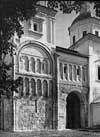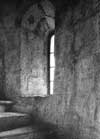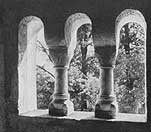| Виртуальный Владимир » Город Владимир » Old Russian Towns » Bogolyubovo » Staircase tower and passage |
 ...
... Road to Bogolyubovo
Road to Bogolyubovo Old township of Bogolyubovo
Old township of Bogolyubovo Palace cathedral
Palace cathedral Staircase tower and passage
Staircase tower and passage Reconstruction of the palace
Reconstruction of the palace Church of the Intercession on the Nerl
Church of the Intercession on the Nerl We shall now enter the staircase tower, restored by L. S. Filippova in 1963, which was a silent witness of the tragedy that took place one dark night in June 1174. Fleeing from the boyars who had stolen into his bed-chamber Andrei managed to crawl down the steps of the tower, badly wounded, and hide in the niche behind the central pillar. It was here that the murderers found him. The events of that bloody night and the uprisings which followed in Vladimir and Bogo-lyubovo are described in Mikula's vivid, passionate account based on the interrogation of the murderers at their trial and the stories of eyewitnesses. The stone steps of the vaulted spiral staircase with its narrow windows lead up to the first floor. Here we find a magnificent triple window with thick columns and carved capitals, looking out over the castle wall to the water-meadows of the Nerl and the gleaming white Church of the Intercession. The wall with the opening into the passage leading to the choir-gallery is decorated with a band of blind arcading. This is the band belonging to the north facade of the passageway. On the right it is covered by the arch of the adjoining tower. Thus we have another example of the practice of decorating the entire building even where an adjoining structure was to be added. It is possible that the new painting on the band showing Prince Andrei before the Virgin Mary with Bishop Leontius of Rostov behind him, is a copy of an earlier one similar to the painting on the blind arcading on the Cathedral of the Assumption at Vladimir.
We shall now enter the staircase tower, restored by L. S. Filippova in 1963, which was a silent witness of the tragedy that took place one dark night in June 1174. Fleeing from the boyars who had stolen into his bed-chamber Andrei managed to crawl down the steps of the tower, badly wounded, and hide in the niche behind the central pillar. It was here that the murderers found him. The events of that bloody night and the uprisings which followed in Vladimir and Bogo-lyubovo are described in Mikula's vivid, passionate account based on the interrogation of the murderers at their trial and the stories of eyewitnesses. The stone steps of the vaulted spiral staircase with its narrow windows lead up to the first floor. Here we find a magnificent triple window with thick columns and carved capitals, looking out over the castle wall to the water-meadows of the Nerl and the gleaming white Church of the Intercession. The wall with the opening into the passage leading to the choir-gallery is decorated with a band of blind arcading. This is the band belonging to the north facade of the passageway. On the right it is covered by the arch of the adjoining tower. Thus we have another example of the practice of decorating the entire building even where an adjoining structure was to be added. It is possible that the new painting on the band showing Prince Andrei before the Virgin Mary with Bishop Leontius of Rostov behind him, is a copy of an earlier one similar to the painting on the blind arcading on the Cathedral of the Assumption at Vladimir.
 Let us now enter the passage with its narrow rectangular windows. Looking down through the archway into the excavated interior of the cathedral one is struck by the latter's unusual height. The walls of the passage are decorated with scenes showing the murder of Andrei, painted by monks from the monastery and of no artistic value. The monks insisted that this was Andrei's bedchamber, but in the north wall of the tower on the first floor there is an old archway, now blocked up, which used to lead to the palace.
Let us now enter the passage with its narrow rectangular windows. Looking down through the archway into the excavated interior of the cathedral one is struck by the latter's unusual height. The walls of the passage are decorated with scenes showing the murder of Andrei, painted by monks from the monastery and of no artistic value. The monks insisted that this was Andrei's bedchamber, but in the north wall of the tower on the first floor there is an old archway, now blocked up, which used to lead to the palace.
 We shall now examine the north wall of the tower from the outside. It is identical to that of the cathedral: corner semi-columns with carved capitals, zakomara (later filled in at the corners when the tent-shaped steeple was added) and a band of blind arcading. Above the band we can see a blocked up archway. Scholars used to think that this archway led to a wooden passage connecting the tower with a wooden palace, but excavations have shown that the passage was built of stone. It stood over smooth stone paving with guttering between the slabs to drain away water from the palace courtyard. There was a narrow arched passageway on the ground by the tower (111. 52). Further along were the quarters of the palace guards in an oblong pillar. The entrance to them in the east wall was decorated with a simple, carved band, but the outside of the east wall had a blind arch decorated with strips of gilded bronze. Thus the lower tier was a huge arcade supporting the stone passage to the choir-gallery, decorated on the outside with a band of blind arcading which was continued on the tower as well and linked the various sections into a single whole. The vaulting of the archways was decorated with frescoes and there were occasional pieces of stone carving on the outer walls. Excavations revealed fragments of the blind arcading, frescoes and carving, as well as majolica tiles from the floor of the passage.
We shall now examine the north wall of the tower from the outside. It is identical to that of the cathedral: corner semi-columns with carved capitals, zakomara (later filled in at the corners when the tent-shaped steeple was added) and a band of blind arcading. Above the band we can see a blocked up archway. Scholars used to think that this archway led to a wooden passage connecting the tower with a wooden palace, but excavations have shown that the passage was built of stone. It stood over smooth stone paving with guttering between the slabs to drain away water from the palace courtyard. There was a narrow arched passageway on the ground by the tower (111. 52). Further along were the quarters of the palace guards in an oblong pillar. The entrance to them in the east wall was decorated with a simple, carved band, but the outside of the east wall had a blind arch decorated with strips of gilded bronze. Thus the lower tier was a huge arcade supporting the stone passage to the choir-gallery, decorated on the outside with a band of blind arcading which was continued on the tower as well and linked the various sections into a single whole. The vaulting of the archways was decorated with frescoes and there were occasional pieces of stone carving on the outer walls. Excavations revealed fragments of the blind arcading, frescoes and carving, as well as majolica tiles from the floor of the passage.
Оставить комментарий:



 Виртуальный Владимир
Виртуальный Владимир Область
Область Панорамы города
Панорамы города Организации
Организации Улицы и дома
Улицы и дома Добавить организацию
Добавить организацию О городе
О городе










